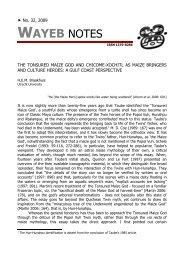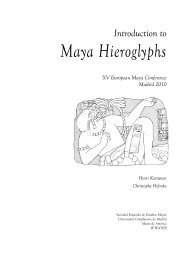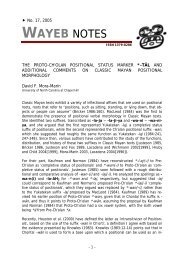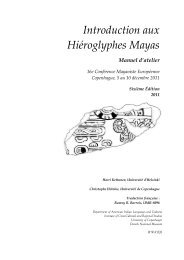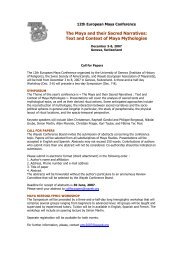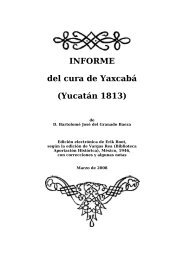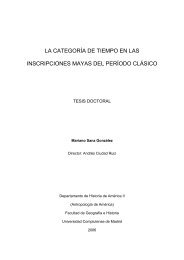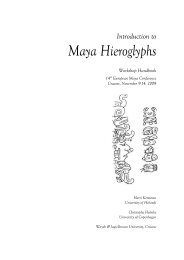Introduction to Maya Hieroglyphs - Wayeb
Introduction to Maya Hieroglyphs - Wayeb
Introduction to Maya Hieroglyphs - Wayeb
You also want an ePaper? Increase the reach of your titles
YUMPU automatically turns print PDFs into web optimized ePapers that Google loves.
Kettunen & Helmke 2011<br />
Glossary of Linguistic Terminology<br />
Another plural suffix present in the script is that of –taak. Its use is limited <strong>to</strong> persons as in the word ch’oktaak<br />
(ch’ok-taak) or “youths”.<br />
object<br />
The element that typically refers <strong>to</strong> the PATIENT in a verbal clause. Verbs and clauses which have an object are<br />
TRANSITIVE – those which do not are INTRANSITIVE. In <strong>Maya</strong> languages objects usually precede SUBJECTS, i.e. the<br />
sentence uchukuw Aj Ukul Yaxuun Bahlam would translate <strong>to</strong> “Yaxuun Bahlam seized Aj Ukul” but in actuality it<br />
says: “Seized Aj Ukul(,) Yaxuun Bahlam. Objects can be divided <strong>to</strong> direct and indirect objects.<br />
oblique object<br />
An oblique OBJECT is a grammatical relation whose characteristics and behavior are explainable more logically in<br />
semantic rather than syntactic terms. In the sentence “Vicky was bitten by a tick” the constituent “by a tick” is an<br />
oblique object<br />
onoma<strong>to</strong>poeia<br />
Onoma<strong>to</strong>poeia refers <strong>to</strong> sounds implied by the phonetic quality of the word, or an entity that produces a sound.<br />
Words such as “hiss” and “bomb” are Onoma<strong>to</strong>poeitic.<br />
onomastics<br />
A branch of SEMANTICS, which studies the etymology of proper names (see also TOPONYM).<br />
onset<br />
An onset is first part of the SYLLABLE preceding the VOWEL.<br />
orthography<br />
The manner in which the sounds of a given language are represented graphically in writing.<br />
palatal<br />
A sound which is produced by narrowing or closing the oral cavity by raising the <strong>to</strong>ngue blade <strong>to</strong>wards the hard<br />
palate. There was only one (pure) palatal sound [j] (graphemically ) and three pala<strong>to</strong>-ALVEOLAR sounds [č],<br />
[č’], and [š] (graphemically , , and , respectively) in the Classic <strong>Maya</strong> language (based on the<br />
pronunciation of modern <strong>Maya</strong> languages).<br />
participle<br />
A nominal form of a verb. Participles can be characterized as being adjectivized verbal forms. They can also be<br />
inflected in cases and in some tenses (and also e.g. in passive): e.g.: (1) Phil is writing hieroglyphs; (2) Phil has<br />
written hieroglyphs; (3) These hieroglyphs were written by Phil. In Ch’olan languages participles are often<br />
referred <strong>to</strong> as stative adjectives. One of the (stative) participles found n the <strong>Maya</strong> script is the term hamliiy (ham-liiy-Ø),<br />
which can be translated as “it was in an opened state”.<br />
particle<br />
A particle is a word that does not belong <strong>to</strong> one of the main classes of words. It is also invariable in form.<br />
Sometimes also PREPOSITIONS are regarded as particles. The following are examples of English particles: “well”,<br />
“oh”, “yes”.<br />
139/154



